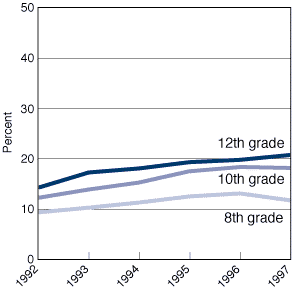 |
News
Volume 13, Number 2 (July, 1998) |
Increases in Teen Drug Use Appear to Level Off
By Sharon Cargo, NIDA NOTES Contributing Writer
Rates of increase in illicit drug use among the Nation's high school students showed some signs of slowing between 1996 and 1997, according to NIDA's annual Monitoring the Future study. The survey, released in December 1997, found that while marijuana use continued to rise among 10th and 12th graders in 1997, use of a number of other drugs began to level off. Drug use among 8th graders actually decreased somewhat. Approximately 51,000 8th-, 10th-, and 12th-grade students in more than 400 public and private schools participated in the 1997 survey.
Current use of any illicit drug - defined as using drugs at least once in the past 30 days - decreased among 8th graders from 14.6 percent in 1996 to 12.9 percent in 1997. Current use of illicit drugs among 10th graders held steady at 23 percent. Twelfth graders showed no significant increase in current drug use. Rates of increases for 12th graders have slowed each year since 1992. (For details about changes for all drugs surveyed, see "Trends in Drug Use Among 8th, 10th, and 12th Graders.")
| Trends in Teens' Current Use of Any Illicit Drugs |

The percentage of 10th and 12th graders who reported having used any illicit drug within the last 30 days - called current use - did not increase significantly from 1996 to 1997. The percentage of 8th graders reporting current use decreased by 1.7%
|
"The possible slowdown of illicit drug use among young people is encouraging even though rates of use remain unacceptably high," says Health and Human Services Secretary Dr. Donna E. Shalala. "All of us, especially parents and teachers, need to redouble our efforts to make young people understand that drug abuse is illegal, dangerous, and wrong."
Increases and Decreases
Marijuana. Among 8th graders, overall marijuana use held steady or decreased rather than increased for the first time since 1992. The percentage of 8th-grade students who reported daily marijuana use showed a decrease, from 1.5 percent in 1996 to 1.1 percent in 1997. The percentage who reported having used marijuana annually or at least once in their lives - called "lifetime use" in the survey - did not change significantly. Some 17.7 percent said they used marijuana annually, and 10.2 percent said they currently used the drug.
Annual and current use of marijuana among 12th graders did not change significantly between 1996 and 1997. However, their lifetime marijuana use rose significantly from 44.9 percent to 49.6 percent, and daily use increased to 5.8 percent in 1997, up from 4.9 percent in the year before. Among 10th graders, lifetime marijuana use increased to 42.3 percent from 39.8 percent in 1996.
Cigarettes and Alcohol. Rates of daily cigarette smoking followed a trend similar to daily marijuana smoking with decreases among 8th graders, increases among 12th graders, and no significant change among 10th graders.
Alcohol use remained generally stable in all three grades, with 8th graders showing some improvement. In 1997, 8.2 percent of 8th graders reported having been drunk within the 30 days before the survey, a decrease from 9.6 percent the year before. No significant changes took place in the percentages of 10th and 12th graders reporting drunkenness in the 30 days before the survey.
Cocaine and Heroin. Rates of cocaine use remained level for 8th- and 10th-grade students, but among 12th graders lifetime use of cocaine in all forms increased. The percentage of seniors who said that they had used cocaine at least once increased from 7.1 percent in 1996 to 8.7 percent in 1997, the highest rate reported since 1990. In 1997, 2.1 percent of 8th, 10th, and 12th graders reported having used heroin at least once in their lives.
Shifting Attitudes
The slowdown in drug use among 8th graders reflects a shift in attitudes. For the first time since 1991, the survey detected an increase in 8th graders' disapproval of drug use. There was increased disapproval of regular marijuana and smokeless tobacco use, frequent drinking and cigarette smoking, and any use of heroin. For example, in 1996, 76.5 percent of 8th graders said they disapproved or strongly disapproved of occasional marijuana use, but in 1997, the number climbed to 78.1 percent. However, fewer 8th graders perceived using marijuana once or twice as being potentially harmful. Eighth graders' disapproval of frequent cigarette smoking - defined in the study as smoking one or more packs per day - increased from 77.3 percent in 1996 to 80.3 percent in 1997.
Disapproval of occasional marijuana use and heavy smoking remained about the same among 10th and 12th graders. The one exception: 10th graders were more disapproving of frequent cigarette smoking, up from 71.6 percent in 1996 to 73.8 percent in 1997.
"The apparent shift in attitudes and leveling off of drug use provide additional evidence that drug abuse prevention activities may be taking hold with young people," says NIDA Director Dr. Alan I. Leshner.
"However, the history of drug use trends has shown that once changes in attitudes begin to occur, it is critical that we not just maintain current levels of effort. We need to redouble our prevention efforts to keep any momentum going. And all sectors need to be working together and conveying similar, accurate antidrug messages."
The NIDA-supported Monitoring the Future survey, which is in its 23rd year, is conducted by the Institute for Social Research at the University of Michigan.
For More Information
Additional information about the Monitoring the Future study can be obtained by calling NIDA's Infofax line at 1-888-NIH-NIDA (644-6432) or by accessing NIDA's home page at http://www.nida.nih.gov and clicking on Information on Drugs of Abuse. Information is also available from the home page of the Institute for Social Research: http://www.isr.umich.edu/src/mtf/.
[NIDA Home Page][NIDA NOTES Index][Index of this Issue]
|